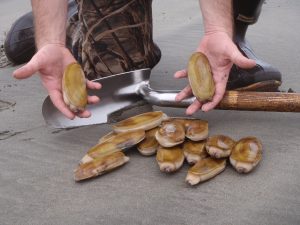Recreational razor clam harvesters in Long Beach, Washington, set a record for one-day digger trips (17,800 diggers) on April 30, 2017. The record number of trips was triggered by the Washington Department of Fish and Wildlife’s (WDFW) first-ever decision to increase the bag limit on razor clams. One factor WDFW considered in making this decision was information from a newly developed forecast, which warned that a future spike in algal toxins could necessitate closing the fishery for the remainder of the season. The decision generated $7M in local revenue and 77,800 digger trips in 11 days, as locals and tourists flocked to the beach to take advantage of the shortened season.

Harmful algal blooms (HABs) of the toxic algae Pseudo-nitzschiaalong the Washington and Oregon coasts produce the neurotoxin domoic acid. When the toxin builds up in shellfish, it can cause amnesic shellfish poisoning in humans. Commercial and recreational shellfisheries are monitored for HAB toxins and are closed when domoic acid exceeds safe levels. Washington’s Long Beach Peninsula, representing 40 percent of the state’s total razor clam habitat was closed to harvesting from October 2016 until this April due to elevated levels of domoic acid in shellfish. Economic hardships caused by the extended closure resulted in lost jobs and a surge in the use of local food bank resources.
This year, a NOAA-sponsored forecast ( Pacific Northwest HAB Bulletin ) gave WDFW confidence to make decisions to open or close harvests, and to take the unprecedented step of increasing the bag limit before toxin levels rose. The Pacific Northwest HAB Forecast and Monitoring System uses offshore and beachside monitoring of ocean conditions and algal and toxin concentrations to predict HAB outbreaks. The system was launched in early 2017 to support management of shellfisheries, clamming beaches, and human health. It is a partnership between NOAA, the University of Washington, the Makah Tribe, the University of Strathclyde, the WDFW, and the Oregon Department of Fish and Wildlife, and is funded by NOAA’s Monitoring and Event Response for Harmful Algal Blooms research program. NOAA is developing a plan to transition the system to permanent operations.
This effort is part of a NOAA ecological forecasting initiative that aims to deliver accurate, relevant, timely, and reliable ecological forecasts directly to coastal resource managers and the public. NOAA is also providing or developing HAB forecasts for the Gulf of Maine, Texas, Florida, and Lake Erie; and hypoxia forecasts for the Gulf of Mexico, Chesapeake Bay, and Lake Erie.
For more information, contact Marc.Suddleson@noaa.gov
